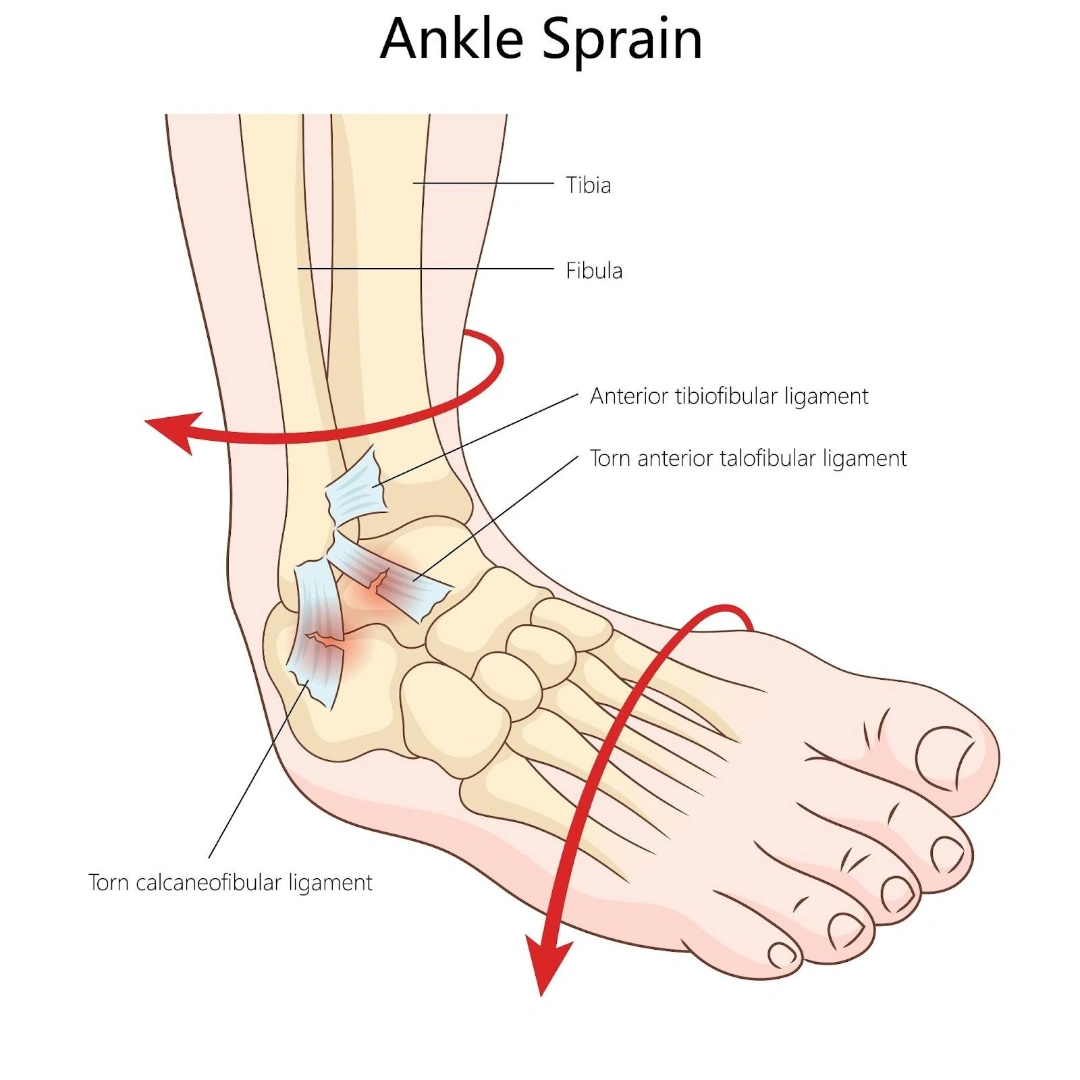Ankle
Instability
- Home
- Conditions We Treat
- Foot & Ankle
- Ankle Instability
What is ankle instability?
Ankle instability is a chronic condition marked by a recurrent sensation of the ankle “giving way,” particularly on the outer (lateral) side. This instability often manifests during physical activities, such as walking on uneven surfaces or engaging in sports, which poses significant challenges for individuals with active lifestyles.
The condition typically arises following repeated ankle sprains, where the ligaments responsible for stabilising the ankle joint become overstretched or torn. When these ligaments fail to heal properly or are not rehabilitated effectively, they may lose their capacity to provide adequate support, leading to instability. Over time, this can result in ongoing discomfort, difficulties maintaining balance, and an increased likelihood of further injuries.
Ankle instability is broadly categorised into two types:
- Mechanical instability — this occurs due to physical damage to the structural components of the ankle, such as ligaments, bones, or cartilage, often leading to a reduction in joint stability.
- Functional instability — this relates to a loss of proprioception (the body’s awareness of joint position) and impaired neuromuscular control, causing a subjective feeling of unsteadiness.


What causes ankle instability?
Ankle instability primarily arises from damage to the ligaments that stabilise the ankle joint. When an ankle is sprained, the ligaments—responsible for connecting bones and maintaining joint alignment—become overstretched or torn. These injuries compromise the structural integrity of the joint, thereby reducing its ability to resist abnormal movements. Over time, repeated ligament injuries can lead to mechanical instability, where the physical structures of the ankle are unable to provide adequate support during movement.
Additionally, the neuromuscular control system, which coordinates muscle responses to maintain joint stability, can become impaired. Following an injury, the sensory feedback mechanisms that help the body recognise joint position, known as proprioception, may be disrupted. This loss of proprioception contributes to functional instability, creating a persistent feeling of unsteadiness and increasing the likelihood of further injuries.
What are the symptoms of ankle instability?
Ankle instability presents with a range of symptoms that affect both physical stability and overall comfort, often interfering with daily activities and physical performance. These symptoms include:
- A recurrent sensation of the ankle “giving way,” particularly during activities on uneven surfaces or while walking.
- Chronic discomfort or persistent pain, especially on the outer side of the ankle.
- Swelling or tenderness around the ankle joint that may worsen with activity.
- A noticeable feeling of instability or wobbliness, even during simple movements.
- Difficulty maintaining balance, leading to a heightened risk of further injuries.

Who is at risk of ankle instability in Singapore?
In Singapore, certain individuals are more prone to developing ankle instability due to specific factors and circumstances:
- Athletes participating in high-impact sports — sports like basketball, football, and tennis involve sudden directional changes and jumping, placing excessive stress on the ankle joint and increasing the likelihood of ligament injuries.
- History of repeated ankle sprains — previous sprains can weaken the ligaments and soft tissues around the ankle, which makes them more susceptible to chronic instability.
- Biomechanical foot abnormalities — conditions such as high arches or flat feet disrupt the alignment and mechanics of the ankle joint, which reduces its ability to maintain stability.
- Jobs with high physical demands — occupations requiring prolonged standing, walking on uneven surfaces, or repetitive ankle movements can strain the joint and increase the risk of instability.
- Weakened muscles or sedentary lifestyle — lack of strength and poor muscle support around the ankle reduce its ability to stabilise during movement, leading to functional instability.
- Age-related ligament changes — older adults may experience reduced ligament elasticity and muscle strength, both of which compromise ankle stability and increase the risk of falls or injuries.
How is ankle instability diagnosed?
Utilising a thorough approach, we evaluate your condition to determine the underlying causes of ankle instability. Our diagnostic methods include:
- Comprehensive medical history assessment — we begin by understanding your history of ankle injuries, sprains, or instability episodes to identify potential contributing factors.
- Physical examination — our specialists assess your ankle’s range of motion, strength, and stability, focusing on areas of pain or tenderness to pinpoint the affected ligaments.
- Stress X-rays — these specialised imaging studies allow us to evaluate the extent of ligament damage and mechanical instability under simulated stress conditions.
- MRI or CT scans — for a more detailed view, we may recommend MRI or CT scan to detect ligament tears, cartilage damage, or other structural abnormalities contributing to your instability.
- Functional stability tests — we assess your balance and proprioception through specific tests to determine the impact of instability on your daily activities and movements.
Who is at risk of ankle instability in Singapore?
At Cove Orthopaedic Clinic, we offer a range of customised treatment options designed to address your ankle instability and help you regain confidence in your mobility. By combining evidence-based approaches with personalised care, we ensure the best possible outcomes for every patient. Our treatment options include:
- Physical therapy — we design personalised physiotherapy programmes to strengthen the muscles around your ankle, improve balance, and restore stability. These exercises are essential for rebuilding proprioception and preventing future injuries.
- Ankle bracing or supports — for added stability, we may recommend wearing ankle braces or supportive devices during daily activities or sports to minimise the risk of further sprains.
- Activity modification — if certain activities aggravate your symptoms, we guide you on safe alternatives while your ankle heals and strengthens, as doing so helps ensure a gradual return to full function.
- Medications for pain and inflammation — anti-inflammatory medications may be prescribed to reduce discomfort and swelling, particularly in the initial stages of treatment.
- Surgical intervention — in severe or chronic cases where non-surgical methods are insufficient, we offer surgical options to repair or reconstruct damaged ligaments. This may include minimally invasive techniques to restore mechanical stability to your ankle.
Our clinical team works closely with you to develop a treatment plan that aligns with your lifestyle and goals, and help ensure a swift and lasting recovery.
If you are experiencing persistent ankle instability or discomfort, schedule a consultation with us today for a personalised assessment and treatment plan to help you get back on your feet confidently.
Conditions We Treat





Frequently asked questions
Can ankle instability lead to arthritis?
Yes, if left untreated, chronic ankle instability can cause repeated injuries to the ankle joint, potentially leading to degenerative changes and the development of osteoarthritis over time.
Is surgery always required for chronic ankle instability?
Not necessarily. While some cases of chronic ankle instability may require surgical intervention, many can be effectively managed with conservative treatments such as physical therapy, bracing, and activity modification.
Can an old ankle sprain cause problems years later?
Yes, it’s common for individuals to experience pain or weakness years after an ankle sprain, especially if the initial injury wasn’t properly treated or rehabilitated. This can lead to chronic instability and discomfort during everyday activities.
What is the difference between a sprain and chronic ankle instability?
A sprain is an acute injury to the ligaments caused by trauma, while chronic ankle instability is a long-term condition characterised by the ankle frequently giving way, often resulting from repeated sprains that haven’t healed properly.
Can physical therapy help with ankle instability?
Yes, physical therapy is a key component in managing ankle instability. Tailored exercises can strengthen the muscles around the ankle, improve balance, and enhance proprioception, reducing the risk of future sprains.



